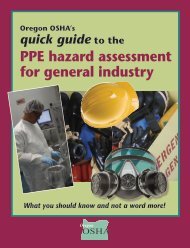Technical Manual - Section 3 (Safety Hazards)
Technical Manual - Section 3 (Safety Hazards)
Technical Manual - Section 3 (Safety Hazards)
Create successful ePaper yourself
Turn your PDF publications into a flip-book with our unique Google optimized e-Paper software.
HEALTH AND SAFETY CONSIDERATIONS<br />
Fire Protection and Prevention<br />
Alkylation units are closed processes; however, the potential<br />
exists for fire should a leak or release occur that allows<br />
product or vapor to reach a source of ignition.<br />
<strong>Safety</strong><br />
Sulfuric acid and hydrofluoric acid are potentially hazardous<br />
chemicals. Loss of coolant water, which is needed to<br />
maintain process temperatures, could result in an upset.<br />
Precautions are necessary to ensure that equipment and<br />
materials that have been in contact with acid are handled<br />
carefully and are thoroughly cleaned before they leave the<br />
process area or refinery. Immersion wash vats are often<br />
provided for neutralization of equipment that has come into<br />
contact with hydrofluoric acid. Hydrofluoric acid units should<br />
be thoroughly drained and chemically cleaned prior to<br />
turnarounds and entry to remove all traces of iron fluoride<br />
and hydro-fluoric acid. Following shutdown, where water has<br />
been used the unit should be thoroughly dried before<br />
hydrofluoric acid is introduced.<br />
Leaks, spills, or releases involving hydrofluoric acid or<br />
hydrocarbons containing hydrofluoric acid can be extremely<br />
hazardous. Care during delivery and unloading of acid is<br />
essential. Process unit containment by curbs and drainage and<br />
isolation so that effluent can be neutralized before release to<br />
the sewer system should be considered. Vents can be routed<br />
to soda-ash scrubbers to neutralize hydrogen fluoride gas or<br />
hydrofluoric acid vapors before release. Pressure on the<br />
cooling water and steam side of exchangers should be kept<br />
below the minimum pressure on the acid service side to<br />
prevent water contamination.<br />
Some corrosion and fouling in sulfuric acid units may occur<br />
from the breakdown of sulfuric acid esters or where caustic is<br />
added for neutralization. These esters can be removed by<br />
fresh acid treating and hot-water washing. To prevent<br />
corrosion from<br />
hydrofluoric acid, the acid concentration inside the process<br />
unit should be maintained above 65% and moisture below<br />
4%.<br />
Health<br />
Because this is a closed process, exposures are expected to be<br />
minimal during normal operations. There is a potential for<br />
exposure should leaks, spills, or releases occur. Sulfuric acid<br />
and (particularly) hydrofluoric acid are potentially hazardous<br />
chemicals. Special precautionary emergency preparedness<br />
measures and protection appropriate to the potential hazard<br />
and areas possibly affected need to be provided. Safe work<br />
practices and appropriate skin and respiratory personal<br />
protective equipment are needed for potential exposures to<br />
hydro-fluoric and sulfuric acids during normal operations<br />
such as reading gauges, inspecting, and process sampling, as<br />
well as during emergency response, maintenance, and<br />
turnaround activities. Procedures should be in place to ensure<br />
that protective equipment and clothing worn in hydrofluoric<br />
acid activities are decontaminated and inspected before<br />
reissue. Appropriate personal protection for exposure to heat<br />
and noise also may be required.<br />
SWEETENING AND TREATING<br />
PROCESSES<br />
Treating is a means by which contaminants such as organic<br />
compounds containing sulfur, nitrogen, and oxygen;<br />
dissolved metals and inorganic salts; and soluble salts<br />
dissolved in emulsified water are removed from petroleum<br />
fractions or streams. Petroleum refiners have a choice of<br />
several different treating processes, but the primary purpose<br />
of the majority of them is the elimination of unwanted sulfur<br />
compounds. A variety of intermediate and finished products,<br />
including middle distillates, gasoline, kerosene, jet fuel and<br />
sour gases are dried and sweetened. Sweetening, a major<br />
refinery treatment of gasoline, treats sulfur compounds<br />
(hydrogen sulfide, thiophene and mercaptan) to improve<br />
color, odor and oxidation stability. Sweetening also reduces<br />
concentrations of carbon dioxide.<br />
III:2-41
















